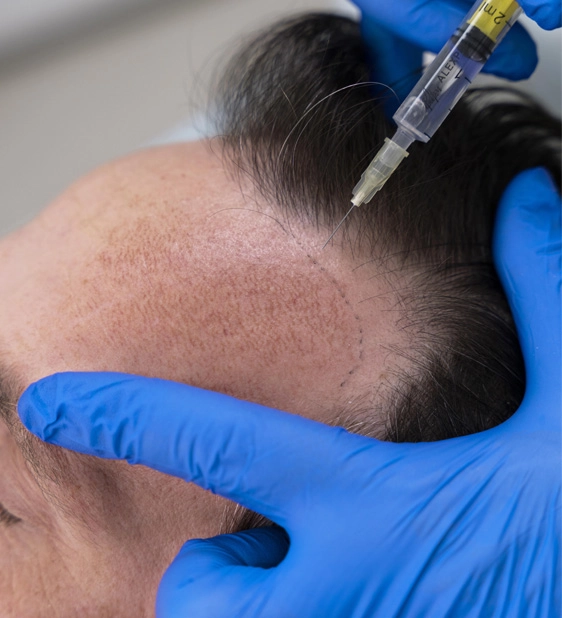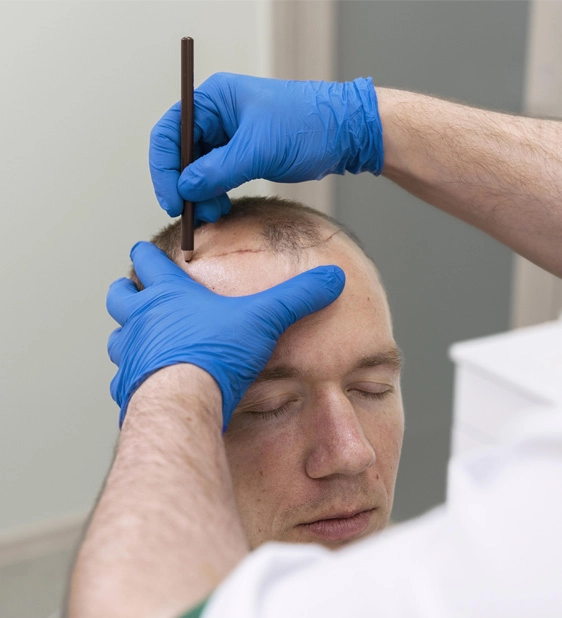What is a Hair Transplant?
A hair transplant is a surgical procedure that involves transferring hair follicles from one part of the body, known as the donor site, to the balding or thinning area, known as the recipient site. This procedure is primarily used to treat male pattern baldness. Hair transplantation techniques, such as Follicular Unit Extraction (FUE) and Follicular Unit Transplantation (FUT), are commonly used. The process involves hair grafts, which contain hair follicles that are genetically resistant to balding. This hair plant technique is also utilized for restoring eyelashes, eyebrows, beard hair, chest hair, and to fill in scars caused by accidents or surgeries. At V for Aesthetics in Turkey, hair transplant procedures are conducted with utmost precision, ensuring natural-looking results.

FUE (Follicular Unit Extraction) Technique
Follicular Unit Extraction (FUE) is a highly advanced technique in the field of hair transplantation. This method has gained significant popularity due to its minimally invasive nature and the natural-looking results it offers. During an FUE procedure, individual hair follicles are extracted one by one from the donor area, typically at the back of the head where hair is more resistant to balding.
The process begins with the patient undergoing local anesthesia to minimize discomfort. Using precise microsurgical tools, the surgeon carefully extracts each follicular unit. These units can contain one to four hairs, and their removal leaves tiny punctures that heal with minimal scarring. Unlike the traditional strip method, FUE does not involve the removal of a strip of scalp, thereby avoiding a linear scar.
The extracted follicles are then prepared for transplantation to the balding areas. The surgeon makes tiny incisions in the recipient area and meticulously places each graft, paying close attention to the angle, direction, and distribution of the hairs to ensure a natural and dense hairline.
The FUE technique’s major advantages include a shorter recovery time, reduced scarring, and the ability to resume normal activities relatively quickly. It’s particularly suitable for patients who prefer to wear their hair short, as the tiny scars are barely noticeable. At V for Aesthetics in Turkey, FUE hair transplantation is performed with precision and care, ensuring patients achieve the best possible outcomes with a natural hair appearance.
Does Hair Transplant Damage Healthy Hair?
One common concern among those considering a hair transplant is whether the procedure will damage existing healthy hair. The short answer is that when performed by skilled and experienced surgeons, a hair transplant, including techniques like FUE (Follicular Unit Extraction) and FUT (Follicular Unit Transplantation), is designed to minimize any harm to your existing hair.
During a hair transplant, the surgeon takes care to work around the healthy hair. Advanced techniques involve extracting or transplanting hair follicles without affecting the surrounding hair. In some cases, there can be temporary thinning of pre-existing hair, known as shock loss, but this is usually a temporary condition and the hair typically grows back.
At V for Aesthetics in Turkey, hair transplantation is performed with precision, ensuring the integrity of your existing healthy hair is maintained. The goal of a hair transplant is to enhance the overall density and appearance of hair, not to compromise the existing healthy hair.
Are You a Suitable Candidate for Hair Transplant?
Determining whether you are a suitable candidate for a hair transplant involves several factors. Ideal candidates are those experiencing hair loss or thinning hair and have sufficient hair at the donor site for transplantation. This typically includes individuals with male or female pattern baldness.
Good candidates for a hair transplant should be in overall good health to ensure proper healing and reduce the risk of complications. Age is also a consideration; while there’s no specific age limit, it’s important to have realistic expectations about the results based on age-related changes in hair density and quality.
During a consultation at V for Aesthetics in Turkey, potential candidates are evaluated based on the degree of hair loss, the quality and density of the donor hair, and their overall health and expectations. A thorough examination helps in determining the most suitable hair transplantation method, be it FUE, FUT or another technique.
Benefits of Hair Transplant?
Hair transplant surgery offers numerous benefits for individuals experiencing hair loss or thinning hair. Here are some of the key advantages:
Improved Appearance: One of the primary benefits of a hair transplant is the significant improvement in your overall appearance. It fills in thinning areas and bald spots, giving a fuller, natural-looking head of hair.
Permanent Solution: Unlike temporary solutions for hair loss, such as wigs or hairpieces, hair transplantation offers a permanent remedy. The transplanted hair generally continues to grow for a lifetime.
Boost in Confidence: Restoring a fuller head of hair often leads to increased self-esteem and confidence, as many individuals feel more attractive and youthful.
Natural Hair Growth: Hair transplantation, using techniques like FUE (Follicular Unit Extraction) and FUT (Follicular Unit Transplantation), uses your own hair, ensuring that the transplanted hair matches your existing hair in texture and color.
Low Maintenance: Transplanted hair works just like natural hair and does not require any special shampoos or chemicals to maintain its density and growth.
Cost-Effective in the Long Run: While the initial cost might seem high, hair transplantation can be more cost-effective compared to ongoing, non-surgical treatments for hair loss.
How common is Hair Transplant?
Hair transplant procedures have become increasingly common worldwide as a viable solution for hair loss and thinning. The popularity of hair transplantation can be attributed to several factors:
Advancements in Technology: With the development of techniques like FUE and FUT, hair transplants have become more efficient and effective, leading to more natural-looking results.
Increased Awareness: Greater awareness and social acceptance of cosmetic surgery have encouraged more individuals to consider hair transplantation as a solution for hair loss.
Global Accessibility: The availability of hair transplant services in countries like Turkey, known for high-quality yet affordable hair transplantation, has made the procedure more accessible to a global audience.
Success Rates: The high success rate and satisfaction among patients who have undergone hair transplantation further contribute to its popularity.
Wide Application: Hair transplant techniques are not only used for scalp hair restoration but also for enhancing eyebrows, beards, and correcting scars, making it a versatile procedure.
How to Prepare for a Hair Transplant?
Preparing for a hair transplant, such as FUE (Follicular Unit Extraction) or FUT (Follicular Unit Transplantation), starts with a thorough initial consultation with your surgeon. In this consultation, typically offered at specialized clinics like V for Aesthetics in Turkey, your hair loss pattern will be assessed, and your hair transplantation goals discussed. The surgeon will provide detailed instructions on how to prepare for the surgery. This often includes avoiding certain medications that can increase bleeding, such as aspirin or blood thinners, and stopping any supplements that might affect the procedure’s outcome.
Patients are usually advised to refrain from smoking and consuming alcohol for a specified period before the hair transplant, as these can hinder the healing process. It’s also recommended to wash your hair with a prescribed shampoo before the surgery and to avoid cutting your hair, as longer hair can help cover the treated areas during recovery. The night before the hair operation, you should get plenty of rest and avoid eating or drinking anything after midnight if general anesthesia will be used.
Hair Transplant Surgical Process
The hair transplant surgical process typically involves several key steps, regardless of whether you’re undergoing an FUE or FUT procedure. On the day of the surgery at V for Aesthetics in Turkey, the treatment area is first prepared, and local anesthesia is administered to minimize discomfort. In an FUE hair transplant, individual hair follicles are extracted one at a time from the donor area. These follicles are then meticulously prepared under a microscope and transplanted to the balding or thinning areas. In an FUT hair transplant, a strip of scalp is removed from the donor area, and hair grafts are harvested from this strip before being transplanted to the recipient area.
The placement of the hair grafts is done with careful consideration to the direction and angle of natural hair growth to ensure a natural-looking result. The hair transplant surgery can take several hours, depending on the extent of the transplant needed. Once completed, the scalp is bandaged, and post-operative instructions are provided to guide you through the recovery process.
Hair Transplant Recovery: What to Expect
Recovering from a hair transplant, whether it’s an FUE (Follicular Unit Extraction) or FUT (Follicular Unit Transplantation), involves a specific process. After the procedure, you can expect some degree of scalp tenderness, and it is normal to have some swelling and bruising around the forehead and eyes for a few days. Pain is generally minimal and can be managed with prescribed medication.
During the first few days, it’s important to sleep with your head elevated to reduce swelling. The surgeon will provide instructions on how to care for your scalp, including gentle washing and avoiding vigorous activities. Small crusts may form around the hair grafts, but these typically fall off within a week or two. Most patients can return to work and resume normal activities within a week, although strenuous exercise should be avoided for a few weeks.
New hair growth from the transplanted follicles is typically seen within a few months, with more noticeable results appearing after six to nine months. It’s important to have realistic expectations and patience, as the final results of a hair transplant take time to fully develop.
Risks of Hair Transplant
As with any surgical procedure, there are certain risks associated with hair transplantation. The most common risks include:
Infection and Bleeding: As with any surgery, there is a risk of infection and minor bleeding during and after the hair transplant procedure.
Scarring: In FUT hair transplants, there’s a risk of noticeable scarring where the strip of scalp was removed. FUE procedures typically result in less noticeable scarring.
Unnatural-Looking Results: If not done by an experienced surgeon, the transplanted hair may not look natural. It’s crucial to choose a skilled surgeon to ensure the hair appears as natural as possible.
Numbness or Lack of Sensation: Some patients may experience temporary numbness or a lack of sensation in the treated areas.
Folliculitis: In some cases, patients might develop inflammation or infection in the hair follicles, known as folliculitis, but this is usually treatable with antibiotics.
At V for Aesthetics in Turkey, experienced surgeons use advanced techniques to minimize these risks and ensure a safe and effective hair transplant process.
Maintaining Long-Term Results: Post-Hair Transplant Care
After undergoing a hair transplant, whether it’s FUE (Follicular Unit Extraction) or FUT (Follicular Unit Transplantation), proper post-hair transplant care is crucial for maintaining long-term results. The key to preserving the benefits of your hair transplant lies in following the post-operative care instructions provided by your surgeon. This includes gentle washing of your hair according to the recommended schedule, avoiding harsh chemical treatments or heat styling tools for a specified period, and protecting the scalp from direct sun exposure.
A balanced diet rich in nutrients, vitamins, and minerals can support hair growth and improve the overall health of your hair. Staying hydrated and avoiding smoking are also important, as they can impact the quality and longevity of the transplanted hair. Regular follow-up appointments with your surgeon at V for Aesthetics in Turkey or your local healthcare provider are essential to monitor the progress of your hair transplant and address any concerns.
It’s also important to maintain realistic expectations about hair growth. While transplanted hair typically starts to grow a few months after the procedure, it can take up to a year or more to see the full results of your hair transplant.
Results of the Hair Transplant Permanent?
The results of a hair transplant are generally considered permanent. The procedure involves transplanting hair follicles from a donor area, where hair is more resistant to balding, to the recipient area. These transplanted hairs retain their genetic characteristics, meaning they are less likely to fall out than the original hair in the recipient area.
However, it’s important to note that a hair transplant does not prevent new hair loss from occurring. Some patients may continue to experience hair thinning or loss in different areas of their scalp, which might require additional treatment or hair transplants in the future. The permanency of the hair transplant results can also be influenced by factors such as the patient’s age, hair quality, lifestyle, and adherence to post-operative care.
Regular consultations with your hair transplant surgeon can help assess your overall hair health and determine if any further treatment is needed to maintain the appearance of your hair.
Is Hair Transplant Painful?
The question of pain during and after a hair transplant procedure, such as FUE (Follicular Unit Extraction) or FUT (Follicular Unit Transplantation), is a common concern. The experience of pain can vary from person to person, but generally, hair transplant surgeries are not considered to be overly painful.
During the Procedure: Hair transplant surgeries are performed under local anesthesia, which numbs the scalp. This means that during the procedure itself, you should not feel any pain. Some patients may feel a slight discomfort or pressure, but actual pain is typically not experienced.
Post-Operative Discomfort: After the procedure, once the anesthesia wears off, it’s normal to experience some soreness or discomfort in the treated area. This discomfort is usually mild and can be effectively managed with prescribed pain medications.
Recovery Period: During the initial days following a hair transplant, you might experience some swelling and tenderness in the scalp. These symptoms are a normal part of the healing process and usually subside within a few days. The post-operative instructions provided by your surgeon will include tips on how to minimize discomfort and facilitate a smooth recovery.
Pain Management: If pain or discomfort is a concern, your surgeon can provide guidance on appropriate pain management strategies to ensure your comfort throughout the recovery process.
Overall, while a hair transplant may involve some level of discomfort, significant pain is uncommon. The advancements in hair transplantation techniques have made the process more comfortable for patients, and the focus on patient care at clinics like V for Aesthetics in Turkey ensures that any discomfort is minimized.

Hair Transplant Prices
When considering a hair transplant, understanding the associated costs is crucial. Hair transplant prices can vary significantly based on various factors such as the technique used (FUE or FUT), the extent of the transplant area, and the geographic location of the clinic. At V for Aesthetics in Turkey, we offer competitive hair transplant prices without compromising on quality and care. Our clinic provides a transparent breakdown of costs, ensuring patients understand what is included in the hair transplant price. While researching hair transplant prices, remember that choosing an experienced and reputable surgeon is key to achieving the best outcomes and value for your investment.
Hair Transplant in Turkey
Turkey has become a leading destination for hair transplantation, renowned for combining quality, affordability, and expertise. Choosing to have a hair transplant in Turkey at a reputable clinic like V for Aesthetics means benefiting from advanced surgical techniques and experienced surgeons at a fraction of the cost compared to many Western countries. The popularity of getting a hair transplant in Turkey is driven by the high standard of medical care, state-of-the-art facilities, and the attractive prices offered. Patients who choose to have their hair transplant in Turkey not only receive top-notch medical care but also enjoy the beauty and culture of Turkey during their recovery.
Hair Transplant Near Me
For those searching for a “hair transplant near me” V for Aesthetics in Turkey is an excellent option to consider. Our clinic is renowned for its high standards in performing hair transplants, employing advanced FUE and FUT techniques. When looking for a “hair transplant near me,” it’s essential to consider the expertise of the surgeons and the quality of the facility. We ensure that each hair transplant procedure is tailored to the individual’s needs, providing comprehensive care from the initial consultation to post-operative follow-ups. By choosing V for Aesthetics for your “hair transplant near me,” you are assured of receiving world-class treatment and care for your hair restoration needs.
For More Information
Please do not hesitate to contact us for more information on the subject.
